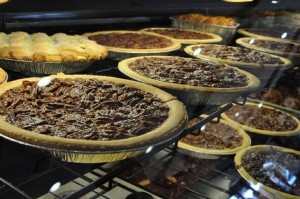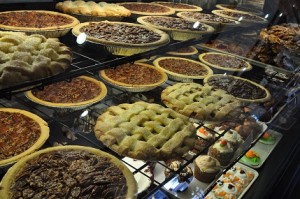Here in our bakery, we’re pretty serious about what we do. Some might call us a bit “pie-ous” 😉 As such, it’s important for us- nay, it is our DUTY- to share some very important information for you. Hang on tight and pull up a pad and pencil – you’re going to want to take notes!
• Pie has been around since the ancient Egyptians. The first pies were made by early Romans who may have learned about it through the Greeks. These pies were sometimes made in “reeds” which were used for the sole purpose of holding the filling and not for eating with the filling.
• The Romans must have spread the word about pies around Europe as the Oxford English Dictionary notes that the word “pie” was popular in the 14th century. The first pie recipe was published by the Romans for a rye-crusted goat cheese and honey pie.
• The early pies were predominately meat pies. Pyes (pies) originally appeared in England as early as the twelfth century. The crust of the pie was referred to as “coffyn”. There was actually more crust than filling. Often these pies were made using fowl and the legs were left to hang over the side of the dish and used as handles. Fruit pies or tarts (pasties) were probably first made in the 1500s. English tradition credits making the first cherry pie to Queen Elizabeth I.
• Pie came to America with the first English settlers. The early colonists cooked their pies in long narrow pans calling them “coffyns” like the crust in England. As in the Roman times, the early American pie crusts often were not eaten, but simply designed to hold the filling during baking. It was during the American Revolution that the term crust was used instead of coffyn.
• The term “as American as apple pie” traces back to 14th century England. The Pilgrims brought their pie-making skills, along with apple seeds, to America. As the popularity of apple pie spread throughout the nation, the phrase grew to symbolize American prosperity.
• Approximately $700 million in pies (about 186 million units) are sold in grocery stores each year. This does not include restaurants, bakeries or food service. If you lined up the number of pies sold at U.S. grocery stores in one year, they would circle the globe and then some.
• According to a 2008 Crisco and American Pie Council survey, nearly one out of five (19 percent) Americans prefer apple pie, followed by pumpkin (13 percent), pecan (12 percent), banana cream (10 percent) and cherry (nine percent).
• The term “upper crust” refers to early America when the economy was difficult and supplies were hard to come by. Only affluent households could afford the ingredients for both the upper and lower crusts of a pie.
 • Shoo-fly pie is a wet-bottom molasses pie that was originally used to sit on window sills to attract flies away from the kitchen.
• Shoo-fly pie is a wet-bottom molasses pie that was originally used to sit on window sills to attract flies away from the kitchen.
• Other names for a pie are pastie, oggie, piraski, piragie, patty and pierogi. More common names include streusel, tart, turnover and crumble.
• When asked what dessert Americans would prefer a friend or family member to bring to their house for a holiday dinner, pie was the winner with 29 percent, followed by cake (17 percent) and cookies (15 percent).
• The wealthy English were known for their “Surprise Pies” in which live creatures would pop out when the pie was cut open.
• At one time, it was against the law to serve ice cream on cherry pie in Kansas.
• Boston Cream Pie is a cake, not a pie.
• Pies are favorite props for humor, particularly when aimed at the pompous. Throwing a pie in a person’s face has been a staple of film comedy since the early days of the medium, and real-life pranksters have taken to targeting politicians and celebrities with their pies, an act called “pieing.”
AND LAST BUT NOT LEAST…
This Sunday (January 23, 2011) is NATIONAL PIE DAY! We’d like to extend an invitation for you to take part in this holiday by taking advantage of our latest offer – $3.00 off ALL pies this weekend! Both Saturday AND Sunday! How sweet is that? 🙂
(Sources: www.piecouncil.org and www.100cafestreet.com (dessert blog).)

